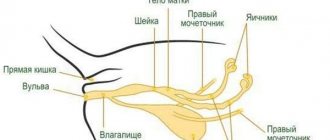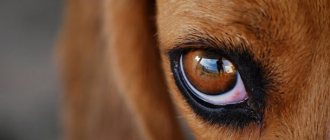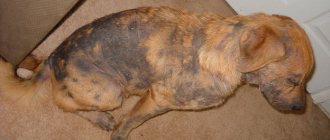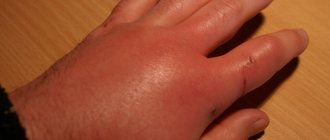Itching is an extremely unpleasant sensation that causes dogs to have an irresistible urge to scratch. In many cases, this may be the first symptom of a disease that has arisen in a pet, so it cannot be ignored.
In different cases, the itching can be local in one or some places or cover all parts of the body at once.
The reasons for its appearance can be different, mainly the following:
- Infection with various types of parasites is one of the most common causes; most often the dog is annoyed by blocks or ticks . Blood-sucking insects are often so small that a person simply does not notice them, and therefore mistakenly excludes their presence as one of the main causes. Itching occurs due to an allergy that develops because parasites treat the bite sites with their saliva to prevent blood clotting. The number of bites that can cause such symptoms depends on the individual characteristics of the pet: if the dog is very sensitive, then a reaction can occur after 1-2 bites.
- Bacteria and fungal spores can also cause your dog to itch actively. Such microflora is always present on the dog’s body and usually does not cause any discomfort, however, in the presence of certain diseases or low immunity, rapid and uncontrolled proliferation of bacteria can begin, which causes various lesions of the skin and coat.
- An allergic reaction is also one of the common causes of itching, the non-food variety being the most common. May occur due to increased sensitivity to house dust, pollen of various plants, insects or other environmental factors.
- Food allergies are much less common than non-food allergies, but they cannot be completely excluded from the probable causes of itching. Various types of food included in the animal’s diet can provoke its manifestation, regardless of the volume of their consumption.
- Itching, which is caused by psychogenic factors, is uncommon. Most often it can be found in hyperactive dogs or pets in a stressful situation, which can be caused by poor living conditions, a stereotypical lifestyle or lack of attention from the owners.
- The presence of various diseases that are not associated with lesions of the skin and fur, as well as the activity of parasites. They are quite rare, itching is usually one of the minor symptoms; only a veterinarian can diagnose and make an accurate diagnosis in such a situation.
- Individual characteristics of the animal, which include increased sensitivity of the skin. Itching usually occurs in this case if the diet is improperly structured.
Diagnosis of itching
Until the causes of this disease are identified and an accurate diagnosis is made, symptoms can only be treated with local remedies.
In order to find out the root causes of the discomfort caused, the following diagnostics are required:
- Taking skin scrapings from areas that are scratched for analysis. This will allow you to identify parasites or microorganisms that affect the dog’s body, if they are the cause.
- Taking scrapings and various secretions from affected areas for analysis if there are itchy formations on the dog’s body.
- Conducting analysis of waste products.
- Visual inspection of the animal to find parasites in its fur. However, if the pet is exposed to water procedures too often, then fleas or their waste products can be quite difficult to detect. If all the symptoms indicate their presence, but parasites are not found, then the specialist will prescribe special additional tests that can help identify their presence.
- Performing a blood test that can help identify the causes of an allergic reaction. This technique for diagnosing itching in dogs is fundamentally new and began to be used in practice relatively recently.
- Intradermal examinations are also used to determine the causes of an allergic reaction. It can be an independent diagnostic method or used in conjunction with a blood test to make a more accurate diagnosis.
The dog is itching: the reason is mites
It is presumptuous to believe that ticks can be detected with the naked eye. The only tick species that causes cheilethiosis
, can be seen with a strong magnifying glass. Outwardly, it looks like ordinary dandruff, but magnification several times will allow you to notice the movement of these dandruff. This is especially noticeable on dark colors. Only a veterinarian can eliminate all ticks! To do this, a scraping is taken from the dog and subjected to thorough analysis in the laboratory.
Another type of mite that causes scabies
, extremely dangerous.
It penetrates so deeply under the skin that it causes particularly aggressive itching. This scabies can make your dog nervous or crazy because the itching never stops. Especially at night, the dog literally tears its skin with intense scratching. .
Another type of tick causes a disease called demodicosis
. Its manifestations are more obvious, especially in the purulent form. First, local redness appears: several pieces covered with small scales. Then they connect with each other, the hair falls out completely. At this stage, the dog itches, leaving severe scratches. Here it is already important to immediately put on a collar, even if you have not yet been to the doctor.
Ixodidosis
provoked by a tick of particular aggressiveness and activity. It digs in and penetrates the skin (usually the hips, neck, ears) and lives inside for some time. It feeds on the dog's blood and begins to grow just under the skin.
Treatment of itching of various etiologies
Complex treatment is prescribed only after the veterinarian has made an accurate diagnosis; its features and specificity depend on the existing disease, since itching itself is usually only one of the symptoms.
Depending on its causes, the following treatment may be used:
- If there is increased irritability and sensitivity of the skin, it is necessary to normalize the dog’s nutrition. The diet should be balanced and contain a significant amount of vitamins and minerals; fatty foods and spices are recommended to be completely excluded. Drops and ointments prescribed by a veterinarian are used, and an alcohol solution of tar is also used, which is prepared in proportions of 1:10. During treatment, water procedures with soothing soap are necessary at least once a week, as well as temporary exclusion of meat from the diet.
- If the itching was caused by a wet variety of lichen, then drugs such as Sulfur and Mercurius are used for treatment. They must be used in accordance with the instructions that come with these products; they can be taken either internally or applied externally to the affected areas. As additional measures, bandages with medicinal ointments and water procedures with creolin soap are used. To speed up the treatment process, it is necessary to temporarily completely exclude meat products and potatoes from the diet.
- When itching caused by lichen sicca, it is necessary to isolate the dog from other animals, since this disease is extremely contagious and there is a high risk of infection of other pets. The animal needs to be bathed and washed as often as possible with regular soothing soap, and before going to bed, treat the affected areas with linseed oil. Phosphorus 3 or Dulcamara 3 is added to food, the daily dosage is no more than five drops.
- Scabies and scab are extremely unpleasant diseases that progress very quickly, the itching is so strong that soon bald spots appear on the animal’s body from frequent scratching. The disease is extremely contagious, so mandatory isolation of the dog from all healthy pets is required. During treatment, a change in diet is necessary; all food should be light, but at the same time nutritious; oatmeal is good. Every other day, water procedures with creolin soap are required; in addition, affected areas on the dog’s body are treated with it. Treatment with linseed oil is also acceptable; this will soften existing scabs, which will speed up the healing process. Sulfur 3 or Mercurius 3 is added to food, the dosage is determined in accordance with the instructions.
- If you have a food allergy, there are a number of difficulties, since even with the help of tests it is extremely difficult to determine what exactly caused it. It is necessary to constantly change the dog’s diet, identifying allergens by elimination, on the basis of which preventive diets are built. If the allergy is caused by non-food factors, but in the vast majority of cases it is chronic and cannot be cured. In such a situation, the veterinarian prescribes medications and determines the specific conditions of detention in order to improve the dog’s condition and relieve it of incessant itching.
In most cases, treatment occurs using various means and drugs; their different groups and effectiveness of use are discussed below:
- Antihistamines can give a positive result and reduce itching only in half of the cases. The only side effect may be an increased degree of drowsiness, otherwise such drugs are the safest and have a fairly mild effect on the body. Most often, experts recommend using them only in the absence of any serious diseases, then there is a chance that the products will help. Typically, several different drugs are tested, which makes it possible to identify the most effective option in practice.
- Natural fatty acids are another option for safe treatment. Usually they do not show a high degree of effectiveness, but in the absence of severe forms of disease or as an adjuvant they give a positive result. The most recommended remedies are fish oil or primrose extract.
- External treatment is carried out using various anti-inflammatory lotions or medicinal ointments. However, it must be taken into account that in a number of individual cases, ordinary cool water can also cause a calming effect.
- Colloidal oatmeal can also be very effective because it has anti-inflammatory effects. It promotes the rapid removal of various toxins from the body, which significantly reduces the burning sensation that irritates the dog, after which it begins to itch less.
- Sulfur-based solutions are not only effective, but also a universal remedy. They destroy parasites that have settled in the animal’s fur, and also reduce the allergic reaction, since it dissolves most of the proteins found in the upper layers of the skin. However, before using any sulfur solutions, it is necessary to take into account that these products have a persistent unpleasant odor and can also change the color of the dog’s coat.
- Antiparasitic shampoos. Today there is a wide range of such products. All of them help to soothe itching and burning, since they have a calming effect, destroy insects and parasites present in the fur, and also eliminate sebum that is secreted in excess. Typically, shampoo is applied to the coat for a certain period of time, after which it will need to be washed off. It is necessary to carefully study the instructions for each specific product, since if such rules are not followed, it will be impossible to achieve a positive result.
- Sprays or solutions containing gummilk. Application is allowed only on dry skin; combined use with sulfur solutions is possible. There is no need to rinse off such products; they dry naturally and, when absorbed into the skin, provide a healing effect.
- Corticosteroids are effective in reducing itching and pain, but these types of drugs often have negative effects on the body. Their use is usually carried out only as prescribed by a veterinarian, if the disease has taken a severe form and the use of such serious means is no longer possible. There are also corticosteroid medications that are intended for external treatment of the affected areas. They are not absorbed into the skin and do not enter the dog’s body, so the negative impact on the animal is minimized in this case. However, their use is still permissible only after consultation and obtaining appropriate permission from a specialist; if they are not diagnosed with any contraindications, then problems usually do not arise.
How to get rid of and remove dog smell (in an apartment, house, car)
The smell of a dog in an apartment, house or car is removed in the same way as all other odors. With one exception, your dog’s bedding can emit a special aroma. Pay closer attention to it; it often emits more odor than the dog itself. The bedding should be washed and cleaned periodically. If it has completely become unusable, throw it away and get a new one.
If your friend often travels with you in the car, give him a special seat. That is, organize bedding in the car too. Then you won't have to clean the inside of the car.
Otherwise, everything is simple: daily wet cleaning, vacuuming, etc. Especially in those places where your dog spends the most time. But the main thing is the dog’s personal hygiene.
A healthy, well-groomed dog will, of course, smell. But not the stench! Dog smell is a natural, normal phenomenon. If your sense of smell is more valuable to you than the loyalty of a reliable friend, get yourself a better cat. Of course there will be smells there too, but that's another story.
Follow-up and prevention
The presence of itching causes great discomfort to the dog and disrupts its normal existence, and identifying the causes and curing it is often quite difficult.
For this reason, it is recommended to follow some preventive measures that minimize the likelihood of this disease occurring, primarily these include the following rules:
- Monitor your pet's diet; fatty foods or foods rich in proteins should not predominate in his diet.
- Carry out periodic treatment against the most common types of parasites. Particular attention should be paid to this during potentially dangerous periods, which are autumn and spring, as well as during walks outside the city and in nature.
- Conduct a periodic visual inspection of the dog's body and coat in order to be able to promptly detect the presence of parasites or any changes in its condition.
- Purchasing hypoallergenic food for dogs with hypersensitivity and a tendency to allergic reactions. Particular attention should be paid to this in the summer.
- Be examined by a veterinarian at least once every six months for dogs taking glucocorticoids.
- Do not bathe your dog too often; the norm is to carry out water procedures no more than once a month, since otherwise the animal begins to lose a significant amount of sebum, which can cause drying of the coat and skin.
Adviсe
To summarize, here are some final tips regarding the issue of itching in dogs:
- When the first symptoms appear, you should urgently visit a specialist and not self-medicate. Itching in most cases is only one of the symptoms, and not an independent disease, and only a veterinarian can make an accurate diagnosis. The sooner this is done, the better, since most ailments are much easier to treat in the initial stages.
- When treating dogs externally, the product should be applied to places where the pet cannot reach and lick it off its fur. For the same reason, isolation from other animals is also required.
- One of the main symptoms that occurs in parallel with itching, which should alert the owner, is an increase in the amount of water consumed. Other factors that require attention are the appearance of unpleasant odors and changes in the pet's behavior.
- If the itching was caused by parasites or fungal formations, then not only treatment of the dog is required, but also disinfection of the entire apartment and pet care items , otherwise relapses are possible.
- If there is any damage on the surface of the skin caused by scratching or other reasons, then it is not allowed to carry out water procedures using shampoo without obtaining permission from a specialist, since this can only increase inflammation and itching.











